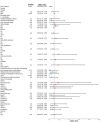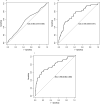Exploring the relationship between total serum calcium and melanoma development: a cross-sectional study
- PMID: 39764412
- PMCID: PMC11702064
- DOI: 10.3389/fnut.2024.1461818
Exploring the relationship between total serum calcium and melanoma development: a cross-sectional study
Abstract
Background: Melanoma is the fourth leading cause of cancer-related death worldwide. The continuous exploration and reporting of risk factors of melanoma is important for standardizing and reducing the incidence of the disease. Calcium signaling is a promising therapeutic target for melanoma; however, the relationship between total serum calcium levels and melanoma development remains unclear.
Methods: In this study, we included patients with melanoma from the National Health and Nutrition Examination Survey (NHANES) database from 2003 to 2006 and from 2009 to 2016. The baseline clinical characteristics of the participants were analyzed using the chi-square and rank-sum tests. Subsequently, a fitted model was constructed to evaluate the relationship between total serum calcium levels and melanoma development. The performance of total serum calcium levels and covariates in predicting the risk of melanoma was assessed based on ROC curves. Finally, LASSO regression analysis was performed using the "glmnet" R package to identify clinical characteristics associated with melanoma.
Results: A total of 13,432 participants were included in this study. Age, race, household poverty-to-income ratio, response of the skin to sunlight after a certain period of non-exposure, wearing long-sleeved shirts, frequency of sunscreen use, and arthritis were significantly correlated with the development of melanoma. The p-values of total serum calcium levels in three fitted models were < 0.05, and the OR values were < 1. According to the ROC curves, the AUC values of models 2 and 3 were 0.728 and 0.766, respectively, indicating that the combination of total serum calcium levels and covariates showed better performance in predicting the occurrence of melanoma. Furthermore, LASSO regression analysis revealed seven clinical characteristics significantly associated with melanoma.
Conclusion: This study revealed a relationship between total serum calcium levels and melanoma development. Total serum calcium levels combined with phenotypic and clinical characteristics were found to be more effective in predicting the occurrence of melanoma. Therefore, the relationship between total serum calcium levels and melanoma development warrants further investigation in prospective cohort studies.
Keywords: LASSO; NHANES; cross-sectional study; melanoma; total serum calcium.
Copyright © 2024 Zhou, Wang, Wang, Li and Ji.
Conflict of interest statement
The authors declare that the research was conducted in the absence of any commercial or financial relationships that could be construed as a potential conflict of interest.
Figures




References
-
- Elder DE, Barnhill RL, Bastian BC, Cook MG, de la Fouchardiere A, Gerami P. Melanocytic tumour classification and the pathway concept of melanoma pathogenesis. In: Elder DE, Massi D, Scolyer RA, Willemze R, editors. WHO classification of skin Tumours. 4th ed. Lyon: International Agency for Research on Cancer; (2018). 66–71.
LinkOut - more resources
Full Text Sources

